外研版九年级上册 Module 5 Unit 1 Don't cross that rope! 教案
文档属性
| 名称 | 外研版九年级上册 Module 5 Unit 1 Don't cross that rope! 教案 |
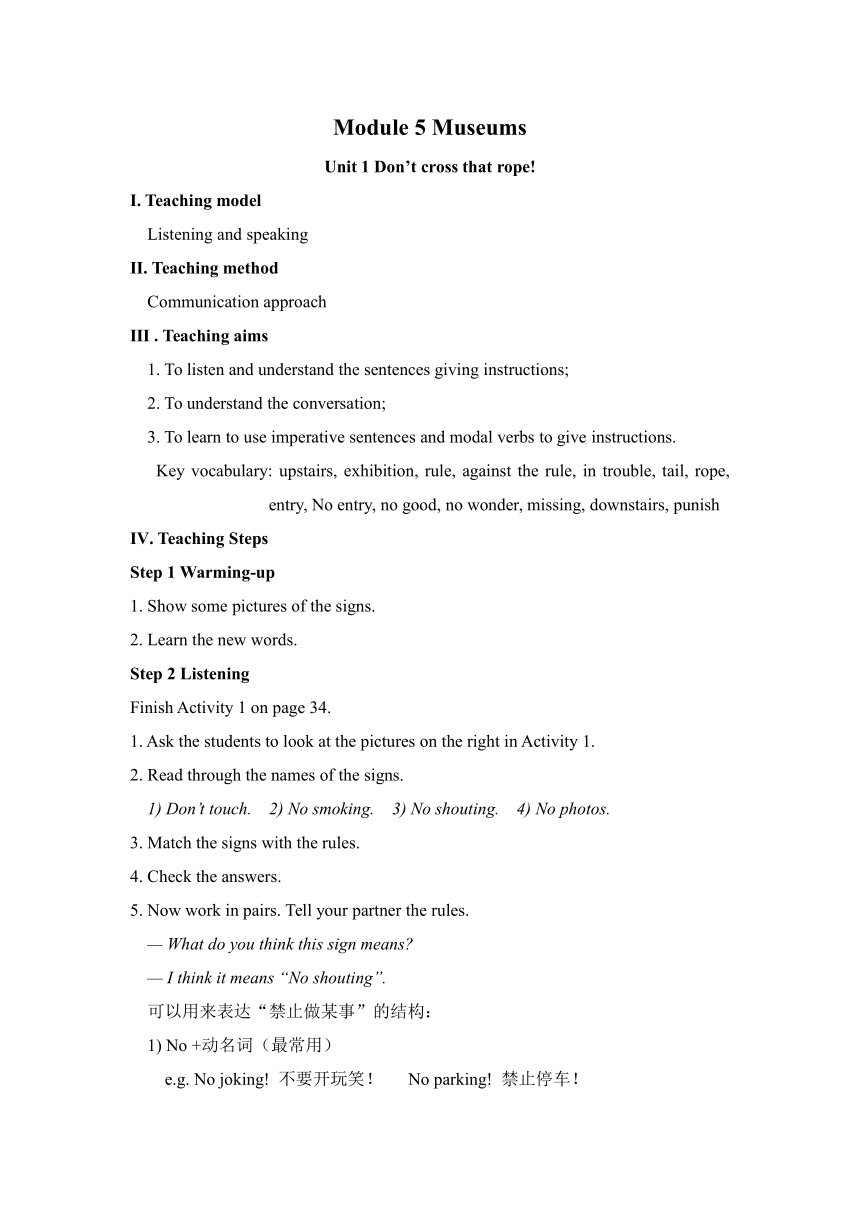
|
|
| 格式 | docx | ||
| 文件大小 | 146.7KB | ||
| 资源类型 | 教案 | ||
| 版本资源 | 外研版 | ||
| 科目 | 英语 | ||
| 更新时间 | 2022-09-07 14:54:01 | ||
图片预览

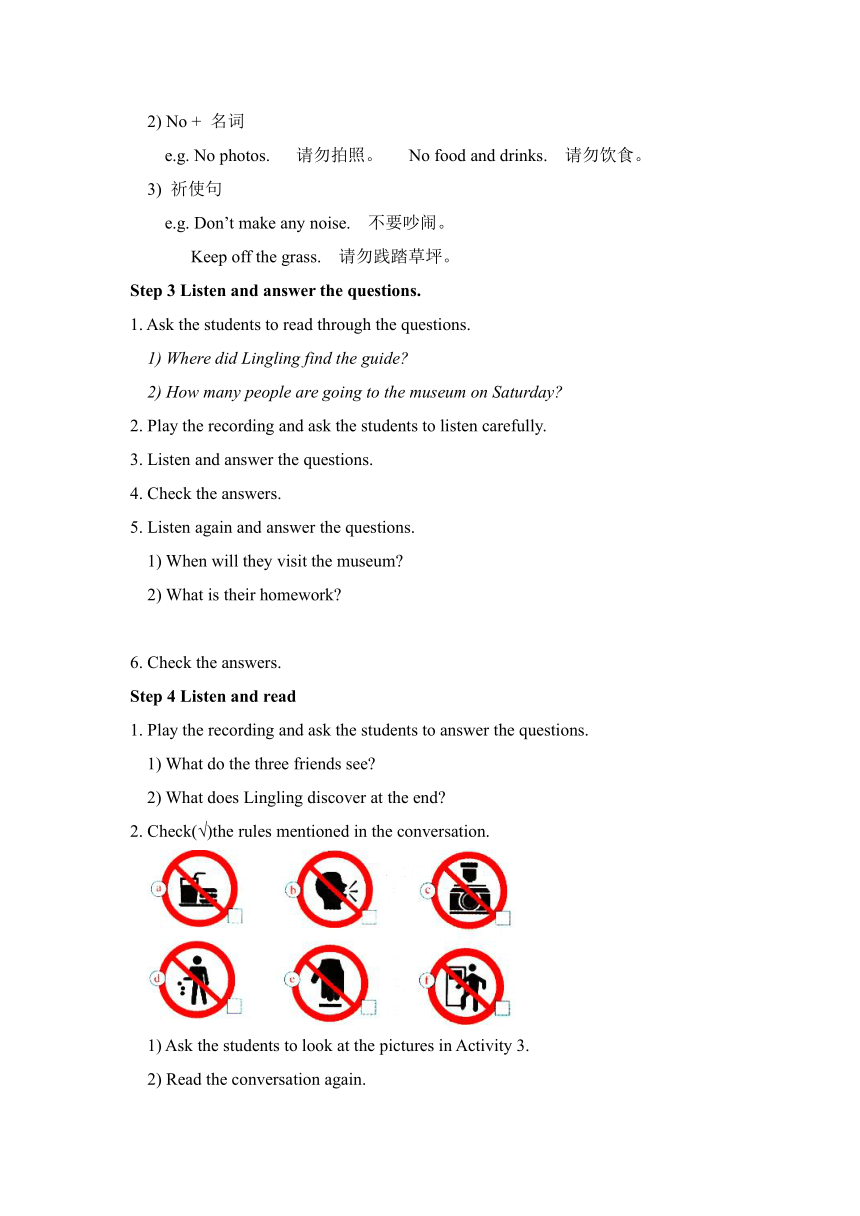
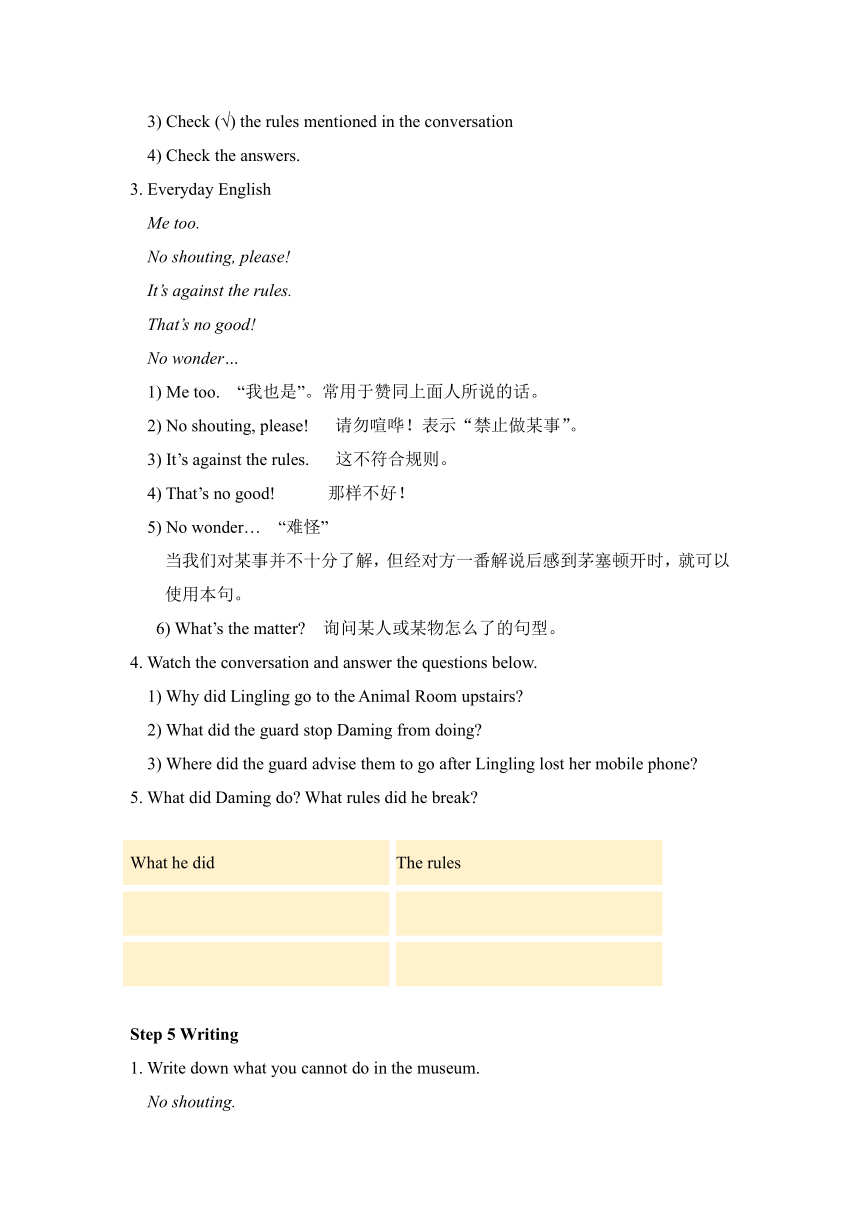
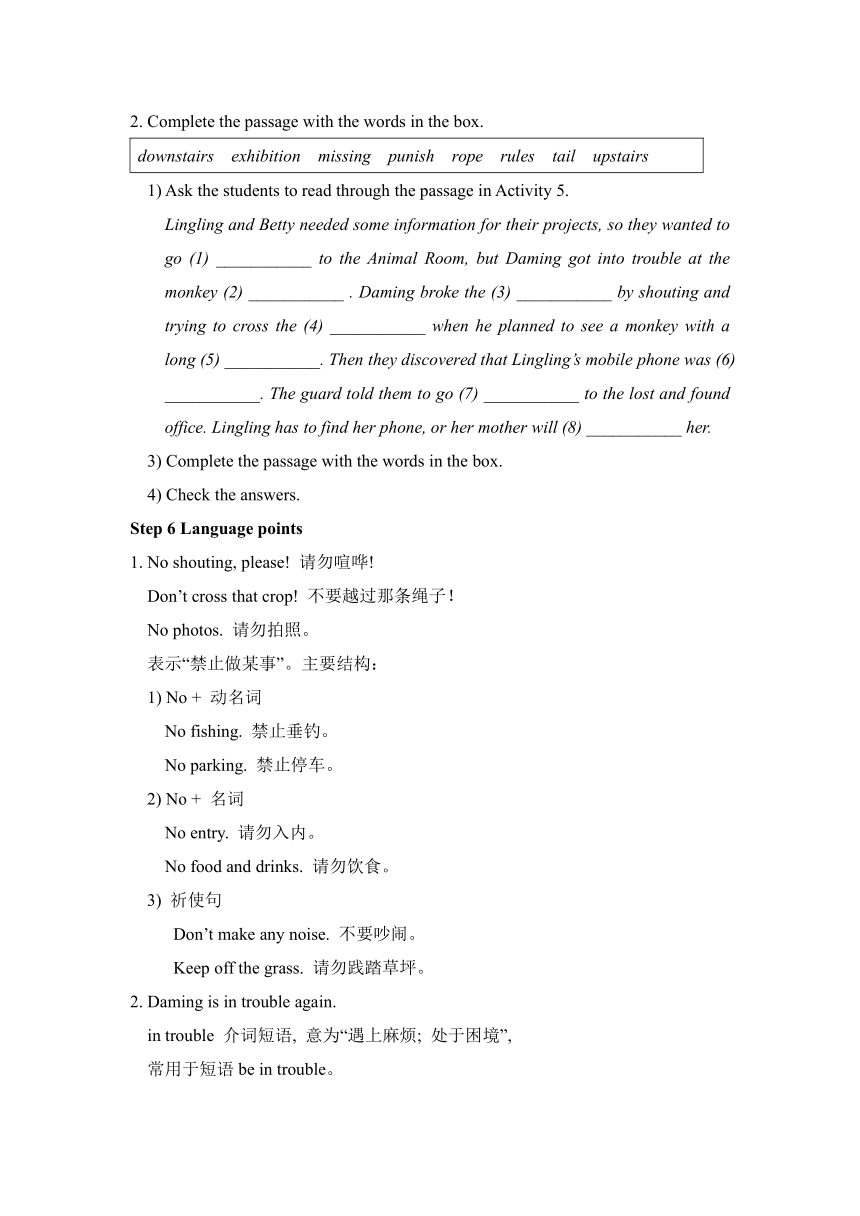
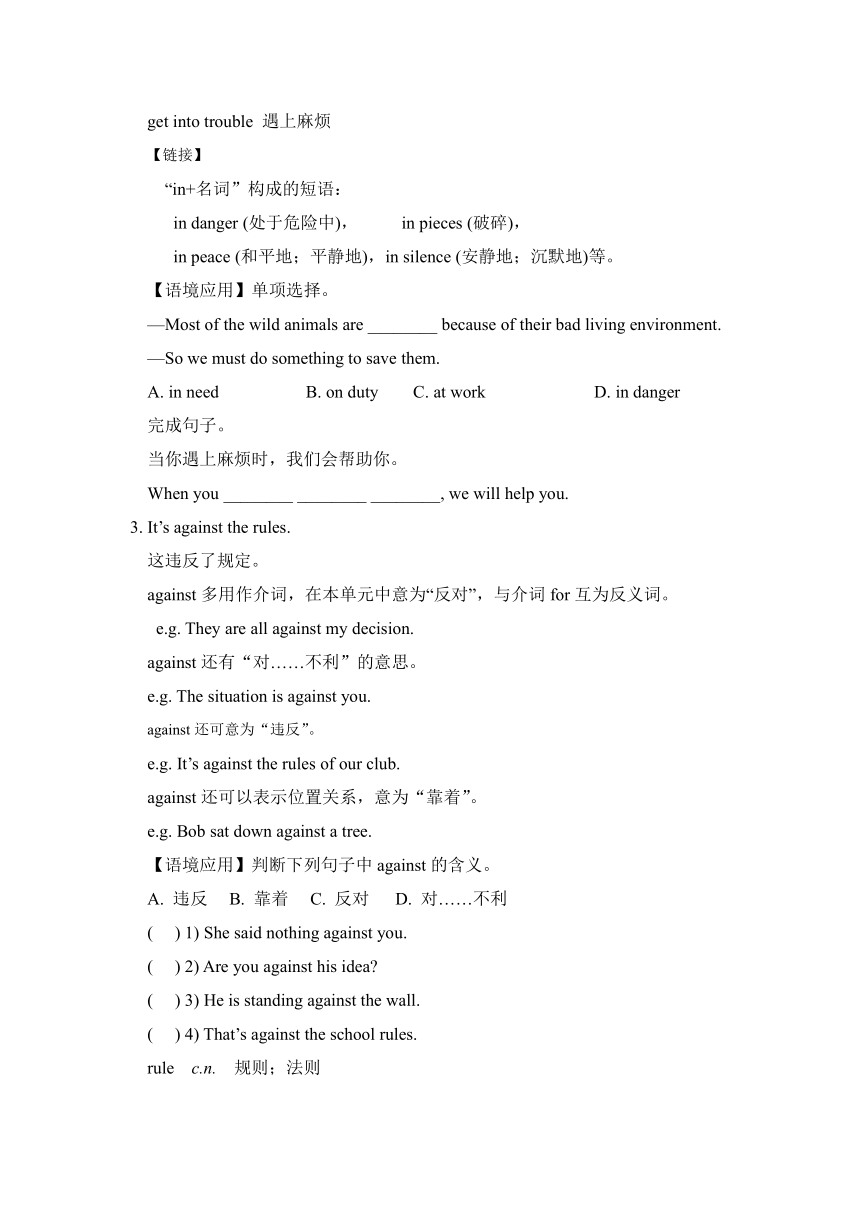
文档简介
Module 5 Museums
Unit 1 Don’t cross that rope!
Ⅰ. Teaching model
Listening and speaking
Ⅱ. Teaching method
Communication approach
Ⅲ . Teaching aims
1. To listen and understand the sentences giving instructions;
2. To understand the conversation;
3. To learn to use imperative sentences and modal verbs to give instructions.
Key vocabulary: upstairs, exhibition, rule, against the rule, in trouble, tail, rope, entry, No entry, no good, no wonder, missing, downstairs, punish
Ⅳ. Teaching Steps
Step 1 Warming-up
1. Show some pictures of the signs.
2. Learn the new words.
Step 2 Listening
Finish Activity 1 on page 34.
1. Ask the students to look at the pictures on the right in Activity 1.
2. Read through the names of the signs.
1) Don’t touch. 2) No smoking. 3) No shouting. 4) No photos.
3. Match the signs with the rules.
4. Check the answers.
5. Now work in pairs. Tell your partner the rules.
— What do you think this sign means
— I think it means “No shouting”.
可以用来表达“禁止做某事”的结构:
1) No +动名词(最常用)
e.g. No joking! 不要开玩笑! No parking! 禁止停车!
2) No + 名词
e.g. No photos. 请勿拍照。 No food and drinks. 请勿饮食。
3) 祈使句
e.g. Don’t make any noise. 不要吵闹。
Keep off the grass. 请勿践踏草坪。
Step 3 Listen and answer the questions.
1. Ask the students to read through the questions.
1) Where did Lingling find the guide
2) How many people are going to the museum on Saturday
2. Play the recording and ask the students to listen carefully.
3. Listen and answer the questions.
4. Check the answers.
5. Listen again and answer the questions.
1) When will they visit the museum
2) What is their homework
6. Check the answers.
Step 4 Listen and read
1. Play the recording and ask the students to answer the questions.
1) What do the three friends see
2) What does Lingling discover at the end
2. Check(√)the rules mentioned in the conversation.
1) Ask the students to look at the pictures in Activity 3.
2) Read the conversation again.
3) Check (√) the rules mentioned in the conversation
4) Check the answers.
3. Everyday English
Me too.
No shouting, please!
It’s against the rules.
That’s no good!
No wonder…
1) Me too. “我也是”。常用于赞同上面人所说的话。
2) No shouting, please! 请勿喧哗!表示“禁止做某事”。
3) It’s against the rules. 这不符合规则。
4) That’s no good! 那样不好!
5) No wonder… “难怪”
当我们对某事并不十分了解,但经对方一番解说后感到茅塞顿开时,就可以使用本句。
6) What’s the matter 询问某人或某物怎么了的句型。
4. Watch the conversation and answer the questions below.
1) Why did Lingling go to the Animal Room upstairs
2) What did the guard stop Daming from doing
3) Where did the guard advise them to go after Lingling lost her mobile phone
5. What did Daming do What rules did he break
What he did The rules
Step 5 Writing
1. Write down what you cannot do in the museum.
No shouting.
2. Complete the passage with the words in the box.
downstairs exhibition missing punish rope rules tail upstairs
1) Ask the students to read through the passage in Activity 5.
Lingling and Betty needed some information for their projects, so they wanted to go (1) ___________ to the Animal Room, but Daming got into trouble at the monkey (2) ___________ . Daming broke the (3) ___________ by shouting and trying to cross the (4) ___________ when he planned to see a monkey with a long (5) ___________. Then they discovered that Lingling’s mobile phone was (6) ___________. The guard told them to go (7) ___________ to the lost and found office. Lingling has to find her phone, or her mother will (8) ___________ her.
3) Complete the passage with the words in the box.
4) Check the answers.
Step 6 Language points
1. No shouting, please! 请勿喧哗!
Don’t cross that crop! 不要越过那条绳子!
No photos. 请勿拍照。
表示“禁止做某事”。主要结构:
1) No + 动名词
No fishing. 禁止垂钓。
No parking. 禁止停车。
2) No + 名词
No entry. 请勿入内。
No food and drinks. 请勿饮食。
3) 祈使句
Don’t make any noise. 不要吵闹。
Keep off the grass. 请勿践踏草坪。
2. Daming is in trouble again.
in trouble 介词短语, 意为“遇上麻烦; 处于困境”,
常用于短语be in trouble。
get into trouble 遇上麻烦
【链接】
“in+名词”构成的短语:
in danger (处于危险中), in pieces (破碎),
in peace (和平地;平静地),in silence (安静地;沉默地)等。
【语境应用】单项选择。
—Most of the wild animals are ________ because of their bad living environment.
—So we must do something to save them.
A. in need B. on duty C. at work D. in danger
完成句子。
当你遇上麻烦时,我们会帮助你。
When you ________ ________ ________, we will help you.
3. It’s against the rules.
这违反了规定。
against多用作介词,在本单元中意为“反对”,与介词for互为反义词。
e.g. They are all against my decision.
against还有“对……不利”的意思。
e.g. The situation is against you.
against还可意为“违反”。
e.g. It’s against the rules of our club.
against还可以表示位置关系,意为“靠着”。
e.g. Bob sat down against a tree.
【语境应用】判断下列句子中against的含义。
A. 违反 B. 靠着 C. 反对 D. 对……不利
( ) 1) She said nothing against you.
( ) 2) Are you against his idea
( ) 3) He is standing against the wall.
( ) 4) That’s against the school rules.
rule c.n. 规则;法则
follow the rules 遵守规则 against the rules 违反规定 / 违背法则
【语境应用】单项选择。
When an earthquake happens, I think the most important safety ________ is to keep calm.
A. rule B. doubt C. condition D. problem
【拓展】
rule n. 控制;统治;支配
【语境应用】完成句子。
(1) 开车时,你必须遵守交通规则。
When you drive, you must _______________________.
(2) 不要在办公室里吃喝,那是违反规定的。
Don’t eat or drink in the office. That’s _______________.
(3) 当时是James I 统治着英格兰。
At that time James I _______________.
4. No wonder the place is empty!
no wonder意为“难怪; 不足为奇”, 常用来表示突然明白某事发生的原因, 其完整结构为It’s no wonder, 其后接that引导的宾语从句, that常可省略。
根据汉语意思完成英语句子,每空一词 (含缩略形式)。
(1) 难怪你累了呢。你一直工作了好几个小时。
____ ________ you’re tired. You’ve been working for hours.
(2) 难怪她那么激动。她很快就要见到她妈妈了。
_____ ____ ________ _____ she is so excited. She’ll see her mother soon.
5. It’s missing! 它丢了!
missing adj. 找不到的; 失踪的
辨析:lost/missing/gone
三者都可表“失去”。lost是广义的“丢失”, 包含可找回和不能找回的意思; missing强调某物或某人暂时找不着了(含最终可能找到之意); gone的含义最广,包括“(东西)没了; (时间)过去了; (人)死了”等,而且语气肯定。
1) ______ time will never be found again.
2) Someone reported to the police that a child was ________.
3) The old times are ______ forever.
6. That phone is new! I have to find it, or Mum will punish me!
那部电话是新的。我一定要找到它,否则妈妈会惩罚我的。
punish v. 惩罚; 惩处
常用于以下两种结构:
(1) punish sb. for sth. / doing sth. 因某事/做某事而惩罚某人
(2) punish sb. by doing sth. 通过做某事惩罚某人
e.g. He was punished for being late.
他因迟到而受到处罚。
【语境应用】完成句子。
1) 昨天经理因为他们迟到而惩罚了他们。
The manager _________ them ________ being late yesterday.
2) 爸爸通过让我为他洗车惩罚了我。
Dad __________ me ________ letting me wash the car for him.
单句语法填空。
You didn't hand in your homework yesterday. Did the teacher give you a(n) ____________ (punish)
【语境应用】完成句子。
1) We all agree that the driver who drives after drinking wine (酒) should be p__________. (2019泰安)
2) The children were _________ (惩罚) for telling lies. (2019南充)
3) 在公交车上不得与司机打架,否则你将会受到惩罚。(or, punish) (2019山东潍坊)
Step 7 Pronunciation and speaking
英语句子一般由多个单词构成,这些单词的重读一般遵循以下规律:
名词、形容词、数词、动词、副词、代词和表达强烈思想感情的感叹词需要重读;
人称代词、连词、冠词、介词、以及少数系动词和助动词等主要起语法作用的单词一般不重读(当然有少数例外)。
1. Play the recording once without stopping.
2. Play the recording again and ask the whole class to repeat.
1) No shouting, please! It’s against the rules.
2) Because it’s closed.
3) There certainly are a lot of rules in this museum.
3. Ask the students to listen and underline the words the speaker stresses.
4. Now listen again and repeat.
Step 8 Discussion
1. Read through the example with the class.
— Must we keep quiet in the classroom
— Yes. No shouting in the classroom.
2. Discuss the rules in your classroom.
3. Work in pairs.
4. Think about the rules in a classroom.
Step 9 Exercises
Ⅰ. 根据语境及所给汉语提示语写出所缺单词。
1. Linda, could you please go ________ (往楼下) and answer the door
2. There is a stamp ________ (展览) in the museum these days.
3. Mr Wang bought a few long ________ (粗绳) in the shop yesterday.
4. At the moment my grandfather is sleeping ________ (在楼上).
Ⅱ. 根据语境及所给首字母提示补全所缺单词。
1. Jack didn't finish his homework, so his dad p________ him.
2. My wallet is m________. Can you help me find it
3. You mustn't enter the room. Look at the sign. It says “No e________”.
4. Look at the dog. It's waving its t________ happily. It's so cute!
Ⅲ. 根据语境从方框中选择恰当的短语填空,每个短语限用一次。
in trouble, against the rules, no wonder, lost and found office
1. —George lost the match this morning.
—________________ he looks unhappy.
2. Don't worry if you're ________________. We can help you.
3. You can't take a pet to the cinema. It's ________________.
4. —My mobile phone is lost.
—Don't worry. Let's go to the ________________.
Ⅳ. 根据括号内的要求完成下列各题,每空一词(含缩略形式)。
1. We need some information for the task. (改为一般疑问句)
________ you ________ ________ information for the task
2. It is a wonderful library. (改为感叹句)
________ ________ ________ library it is!
3. You can't cross the road when the traffic light is red. (改为祈使句)
________ ________ the road when the traffic light is red.
4. What's wrong with you (改为同义句)
What's ________ ________ with you
5. Mrs Zhang is taking photos in the park. (对划线部分提问)
________ Mrs Zhang ________ in the park
6. I'm going to watch a movie this afternoon. (对划线部分提问)
________ ________ you going to ________ this afternoon
Ⅴ. 根据对话内容从方框中选择能填入空白处的最佳选项补全对话,其中有两项多余。
A: Good morning, Andy. (1) _________
B: Yes, I am. Why
A: There is going to be an exhibition in the history museum. Do you know that
B: No, I don't. (2) _________
A: It's about Chinese movies. Would you like to enjoy it with me
B: (3) _________ I'll take my camera and take some photos.
A: No, you can't take photos in the museum.
B: What a pity! (4) _________
A: At 9:00 am at the gate of the museum.
B: OK. (5) _________
A: See you then.
A. Yes, I'd love to. B. What is it about C. See you tomorrow. D. Thank you very much. E. Are you free tomorrow F. When and where shall we meet G. How far is it from here to the museum
答案
Ⅰ. 1. downstairs 2. exhibition 3. ropes 4. upstairs
Ⅱ. 1. punished 2. missing 3. entry 4. tail
Ⅲ. 1. No wonder 2. in trouble 3. against the rules 4. lost and found office
Ⅳ. 1. Do; need any 2. What a wonderful 3. Don't cross 4. the matter / problem
5. What's; doing 6. What are; do
Ⅴ. 1-5 EBAFC
Step 10 Homework
编写一段对话,制定班规。
Unit 1 Don’t cross that rope!
Ⅰ. Teaching model
Listening and speaking
Ⅱ. Teaching method
Communication approach
Ⅲ . Teaching aims
1. To listen and understand the sentences giving instructions;
2. To understand the conversation;
3. To learn to use imperative sentences and modal verbs to give instructions.
Key vocabulary: upstairs, exhibition, rule, against the rule, in trouble, tail, rope, entry, No entry, no good, no wonder, missing, downstairs, punish
Ⅳ. Teaching Steps
Step 1 Warming-up
1. Show some pictures of the signs.
2. Learn the new words.
Step 2 Listening
Finish Activity 1 on page 34.
1. Ask the students to look at the pictures on the right in Activity 1.
2. Read through the names of the signs.
1) Don’t touch. 2) No smoking. 3) No shouting. 4) No photos.
3. Match the signs with the rules.
4. Check the answers.
5. Now work in pairs. Tell your partner the rules.
— What do you think this sign means
— I think it means “No shouting”.
可以用来表达“禁止做某事”的结构:
1) No +动名词(最常用)
e.g. No joking! 不要开玩笑! No parking! 禁止停车!
2) No + 名词
e.g. No photos. 请勿拍照。 No food and drinks. 请勿饮食。
3) 祈使句
e.g. Don’t make any noise. 不要吵闹。
Keep off the grass. 请勿践踏草坪。
Step 3 Listen and answer the questions.
1. Ask the students to read through the questions.
1) Where did Lingling find the guide
2) How many people are going to the museum on Saturday
2. Play the recording and ask the students to listen carefully.
3. Listen and answer the questions.
4. Check the answers.
5. Listen again and answer the questions.
1) When will they visit the museum
2) What is their homework
6. Check the answers.
Step 4 Listen and read
1. Play the recording and ask the students to answer the questions.
1) What do the three friends see
2) What does Lingling discover at the end
2. Check(√)the rules mentioned in the conversation.
1) Ask the students to look at the pictures in Activity 3.
2) Read the conversation again.
3) Check (√) the rules mentioned in the conversation
4) Check the answers.
3. Everyday English
Me too.
No shouting, please!
It’s against the rules.
That’s no good!
No wonder…
1) Me too. “我也是”。常用于赞同上面人所说的话。
2) No shouting, please! 请勿喧哗!表示“禁止做某事”。
3) It’s against the rules. 这不符合规则。
4) That’s no good! 那样不好!
5) No wonder… “难怪”
当我们对某事并不十分了解,但经对方一番解说后感到茅塞顿开时,就可以使用本句。
6) What’s the matter 询问某人或某物怎么了的句型。
4. Watch the conversation and answer the questions below.
1) Why did Lingling go to the Animal Room upstairs
2) What did the guard stop Daming from doing
3) Where did the guard advise them to go after Lingling lost her mobile phone
5. What did Daming do What rules did he break
What he did The rules
Step 5 Writing
1. Write down what you cannot do in the museum.
No shouting.
2. Complete the passage with the words in the box.
downstairs exhibition missing punish rope rules tail upstairs
1) Ask the students to read through the passage in Activity 5.
Lingling and Betty needed some information for their projects, so they wanted to go (1) ___________ to the Animal Room, but Daming got into trouble at the monkey (2) ___________ . Daming broke the (3) ___________ by shouting and trying to cross the (4) ___________ when he planned to see a monkey with a long (5) ___________. Then they discovered that Lingling’s mobile phone was (6) ___________. The guard told them to go (7) ___________ to the lost and found office. Lingling has to find her phone, or her mother will (8) ___________ her.
3) Complete the passage with the words in the box.
4) Check the answers.
Step 6 Language points
1. No shouting, please! 请勿喧哗!
Don’t cross that crop! 不要越过那条绳子!
No photos. 请勿拍照。
表示“禁止做某事”。主要结构:
1) No + 动名词
No fishing. 禁止垂钓。
No parking. 禁止停车。
2) No + 名词
No entry. 请勿入内。
No food and drinks. 请勿饮食。
3) 祈使句
Don’t make any noise. 不要吵闹。
Keep off the grass. 请勿践踏草坪。
2. Daming is in trouble again.
in trouble 介词短语, 意为“遇上麻烦; 处于困境”,
常用于短语be in trouble。
get into trouble 遇上麻烦
【链接】
“in+名词”构成的短语:
in danger (处于危险中), in pieces (破碎),
in peace (和平地;平静地),in silence (安静地;沉默地)等。
【语境应用】单项选择。
—Most of the wild animals are ________ because of their bad living environment.
—So we must do something to save them.
A. in need B. on duty C. at work D. in danger
完成句子。
当你遇上麻烦时,我们会帮助你。
When you ________ ________ ________, we will help you.
3. It’s against the rules.
这违反了规定。
against多用作介词,在本单元中意为“反对”,与介词for互为反义词。
e.g. They are all against my decision.
against还有“对……不利”的意思。
e.g. The situation is against you.
against还可意为“违反”。
e.g. It’s against the rules of our club.
against还可以表示位置关系,意为“靠着”。
e.g. Bob sat down against a tree.
【语境应用】判断下列句子中against的含义。
A. 违反 B. 靠着 C. 反对 D. 对……不利
( ) 1) She said nothing against you.
( ) 2) Are you against his idea
( ) 3) He is standing against the wall.
( ) 4) That’s against the school rules.
rule c.n. 规则;法则
follow the rules 遵守规则 against the rules 违反规定 / 违背法则
【语境应用】单项选择。
When an earthquake happens, I think the most important safety ________ is to keep calm.
A. rule B. doubt C. condition D. problem
【拓展】
rule n. 控制;统治;支配
【语境应用】完成句子。
(1) 开车时,你必须遵守交通规则。
When you drive, you must _______________________.
(2) 不要在办公室里吃喝,那是违反规定的。
Don’t eat or drink in the office. That’s _______________.
(3) 当时是James I 统治着英格兰。
At that time James I _______________.
4. No wonder the place is empty!
no wonder意为“难怪; 不足为奇”, 常用来表示突然明白某事发生的原因, 其完整结构为It’s no wonder, 其后接that引导的宾语从句, that常可省略。
根据汉语意思完成英语句子,每空一词 (含缩略形式)。
(1) 难怪你累了呢。你一直工作了好几个小时。
____ ________ you’re tired. You’ve been working for hours.
(2) 难怪她那么激动。她很快就要见到她妈妈了。
_____ ____ ________ _____ she is so excited. She’ll see her mother soon.
5. It’s missing! 它丢了!
missing adj. 找不到的; 失踪的
辨析:lost/missing/gone
三者都可表“失去”。lost是广义的“丢失”, 包含可找回和不能找回的意思; missing强调某物或某人暂时找不着了(含最终可能找到之意); gone的含义最广,包括“(东西)没了; (时间)过去了; (人)死了”等,而且语气肯定。
1) ______ time will never be found again.
2) Someone reported to the police that a child was ________.
3) The old times are ______ forever.
6. That phone is new! I have to find it, or Mum will punish me!
那部电话是新的。我一定要找到它,否则妈妈会惩罚我的。
punish v. 惩罚; 惩处
常用于以下两种结构:
(1) punish sb. for sth. / doing sth. 因某事/做某事而惩罚某人
(2) punish sb. by doing sth. 通过做某事惩罚某人
e.g. He was punished for being late.
他因迟到而受到处罚。
【语境应用】完成句子。
1) 昨天经理因为他们迟到而惩罚了他们。
The manager _________ them ________ being late yesterday.
2) 爸爸通过让我为他洗车惩罚了我。
Dad __________ me ________ letting me wash the car for him.
单句语法填空。
You didn't hand in your homework yesterday. Did the teacher give you a(n) ____________ (punish)
【语境应用】完成句子。
1) We all agree that the driver who drives after drinking wine (酒) should be p__________. (2019泰安)
2) The children were _________ (惩罚) for telling lies. (2019南充)
3) 在公交车上不得与司机打架,否则你将会受到惩罚。(or, punish) (2019山东潍坊)
Step 7 Pronunciation and speaking
英语句子一般由多个单词构成,这些单词的重读一般遵循以下规律:
名词、形容词、数词、动词、副词、代词和表达强烈思想感情的感叹词需要重读;
人称代词、连词、冠词、介词、以及少数系动词和助动词等主要起语法作用的单词一般不重读(当然有少数例外)。
1. Play the recording once without stopping.
2. Play the recording again and ask the whole class to repeat.
1) No shouting, please! It’s against the rules.
2) Because it’s closed.
3) There certainly are a lot of rules in this museum.
3. Ask the students to listen and underline the words the speaker stresses.
4. Now listen again and repeat.
Step 8 Discussion
1. Read through the example with the class.
— Must we keep quiet in the classroom
— Yes. No shouting in the classroom.
2. Discuss the rules in your classroom.
3. Work in pairs.
4. Think about the rules in a classroom.
Step 9 Exercises
Ⅰ. 根据语境及所给汉语提示语写出所缺单词。
1. Linda, could you please go ________ (往楼下) and answer the door
2. There is a stamp ________ (展览) in the museum these days.
3. Mr Wang bought a few long ________ (粗绳) in the shop yesterday.
4. At the moment my grandfather is sleeping ________ (在楼上).
Ⅱ. 根据语境及所给首字母提示补全所缺单词。
1. Jack didn't finish his homework, so his dad p________ him.
2. My wallet is m________. Can you help me find it
3. You mustn't enter the room. Look at the sign. It says “No e________”.
4. Look at the dog. It's waving its t________ happily. It's so cute!
Ⅲ. 根据语境从方框中选择恰当的短语填空,每个短语限用一次。
in trouble, against the rules, no wonder, lost and found office
1. —George lost the match this morning.
—________________ he looks unhappy.
2. Don't worry if you're ________________. We can help you.
3. You can't take a pet to the cinema. It's ________________.
4. —My mobile phone is lost.
—Don't worry. Let's go to the ________________.
Ⅳ. 根据括号内的要求完成下列各题,每空一词(含缩略形式)。
1. We need some information for the task. (改为一般疑问句)
________ you ________ ________ information for the task
2. It is a wonderful library. (改为感叹句)
________ ________ ________ library it is!
3. You can't cross the road when the traffic light is red. (改为祈使句)
________ ________ the road when the traffic light is red.
4. What's wrong with you (改为同义句)
What's ________ ________ with you
5. Mrs Zhang is taking photos in the park. (对划线部分提问)
________ Mrs Zhang ________ in the park
6. I'm going to watch a movie this afternoon. (对划线部分提问)
________ ________ you going to ________ this afternoon
Ⅴ. 根据对话内容从方框中选择能填入空白处的最佳选项补全对话,其中有两项多余。
A: Good morning, Andy. (1) _________
B: Yes, I am. Why
A: There is going to be an exhibition in the history museum. Do you know that
B: No, I don't. (2) _________
A: It's about Chinese movies. Would you like to enjoy it with me
B: (3) _________ I'll take my camera and take some photos.
A: No, you can't take photos in the museum.
B: What a pity! (4) _________
A: At 9:00 am at the gate of the museum.
B: OK. (5) _________
A: See you then.
A. Yes, I'd love to. B. What is it about C. See you tomorrow. D. Thank you very much. E. Are you free tomorrow F. When and where shall we meet G. How far is it from here to the museum
答案
Ⅰ. 1. downstairs 2. exhibition 3. ropes 4. upstairs
Ⅱ. 1. punished 2. missing 3. entry 4. tail
Ⅲ. 1. No wonder 2. in trouble 3. against the rules 4. lost and found office
Ⅳ. 1. Do; need any 2. What a wonderful 3. Don't cross 4. the matter / problem
5. What's; doing 6. What are; do
Ⅴ. 1-5 EBAFC
Step 10 Homework
编写一段对话,制定班规。
同课章节目录
- Module 1 Wonders of the world
- Unit 1 It's more than 2,000 years old.
- Unit 2 The Grand Canyon was not just big.
- Unit 3 Language in use
- Module 2 Public holidays
- Unit 1 My family always go somewhere interesting a
- Unit 2 We have celebrated the festival since the f
- Unit 3 Language in use
- Module 3 Heroes
- Unit 1 She trained hard,so she became a great play
- Unit 2There were few doctors, so he had to work ve
- Unit 3 Language in use
- Module 4 Home alone
- Unit 1 I can look after myself, although it won’t
- Unit 2 I became so bored with their orders that I
- Unit 3 Language in use
- Module 5 Museums
- Unit 1 Don't cross that rope!
- Unit 2 If you ever go to London, make sure you vis
- Unit 3 Language in use
- Module 6 Problems
- Unit 1 If I start after dinner, I'll finish it be
- Unit 2 If you tell him the truth now, you will sho
- Unit 3 Language in use
- Revision Module A
- Module 7 Great books
- Unit 1 We're still influenced by Confucius's idea
- Unit 2 It is still read and loved.
- Unit 3 Language in use
- Module 8 Sports life
- Unit 1 Daming wasn't chosen for the team last time
- Unit 2 He was invited to competitions around the w
- Unit 3 Language in use
- Module 9 Great inventions
- Unit 1 Will computers be used more than books in t
- Unit 2 Will books be replaced by the Internet?
- Unit 3 Language in use
- Module 10 Australia
- Unit 1 I have some photos that I took in Australia
- Unit 2 The game that they like most is Australian
- Unit 3 Language in use
- Module 11 Photos
- Unit 1 He's the boy who won the photo competition
- Unit 2 The photo which we liked best was taken by
- Unit 3 Language in use
- Module 12 Save our world
- Unit 1 If everyone starts to do something, the wor
- Unit 2 Repeat these three words daily: reduce, reu
- Unit 3 Language in use
- Revision Module B
